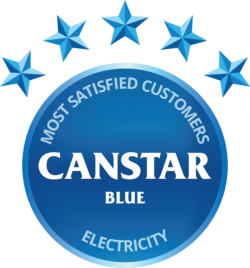How much are you paying for power in your home? Is it more than the average power bill in New Zealand? If it is, you could be paying too much for your power. Canstar Blue explores average power bills and how to find a better deal on your electricity.
Average Power Consumption
The most recent stats show that over the 12 months to the end of September 2024, the average Kiwi household used 7107kWh of electricity, at 33.89c per kWh, for a total cost of $2399. This works out to roughly $200 per month, although most homes use more electricity over winter, and less in summer, due to heating costs.
But these are average figures, as power prices vary considerably around the country. Currently, there’s a variance of over 7c in the price of electricity per kWh, from 20.55c to 27.62c, region to region. And there’s an even bigger disparity in the prices Kiwis pay for the line components of their power bills.
Line charges cover the cost of the infrastructure required to get electricity from the power station to your home. In Cromwell, for example, 20.51c per kWh goes towards line charges, whereas consumers in Nelson pay only 8.49c. That’s quite a difference, which when spread over a year’s consumption can make a big difference to household bills.
→ Related article: Average Electricity Costs per kWh in NZ
Average Power Bills
As you can see, residents in Kerikeri, Northland, face average power bills that are around 46% higher than those of people living in Christchurch.
| Location | Per Year | Per Month |
| Kerikeri | $3222 | $269 |
| Westport | $3221 | $268 |
| Balclutha | $3151 | $263 |
| Greymouth | $3135 | $261 |
| Cromwell | $3034 | $253 |
| Waipukurau | $3010 | $251 |
| Blenhiem | $2958 | $247 |
| Gisborne | $2869 | $239 |
| Taumaranui | $2852 | $238 |
| Otorohanga | $2852 | $238 |
| Dannevirke | $2847 | $237 |
| Hawera | $2790 | $233 |
| Pukekohe | $2788 | $232 |
| Masterton | $2788 | $232 |
| Rangiora | $2785 | $232 |
| Winton | $2783 | $232 |
| Kaiapoi | $2759 | $230 |
| Tauranga | $2748 | $229 |
| Whangarei | $2740 | $228 |
| Oamaru | $2658 | $222 |
| Thames | $2645 | $220 |
| Paraparaumu | $2626 | $219 |
| Queenstown | $2612 | $218 |
| Taupo | $2596 | $216 |
| Whanganui | $2569 | $214 |
| Timaru | $2569 | $214 |
| Rotorua | $2565 | $214 |
| Whakatane | $2558 | $213 |
| Cambridge | $2533 | $211 |
| Dunedin | $2516 | $210 |
| New Plymouth | $2514 | $210 |
| New Zealand | $2513 | $209 |
| Palmerston North | $2495 | $208 |
| Napier | $2446 | $204 |
| Richmond | $2441 | $203 |
| Auckland North Shore | $2415 | $201 |
| Auckland Central | $2410 | $201 |
| Hamilton | $2398 | $200 |
| Nelson | $2396 | $200 |
| Invercargill | $2353 | $196 |
| Ashburton | $2309 | $192 |
| Wellington City | $2270 | $189 |
| Christchurch | $2213 | $184 |
Data: www.mbie.govt.nz Quarterly Survey of Domestic Electricity Prices to November 15, 2024.
High Average Power Bills: What to do about them
Unfortunately, if you live in one of the more expensive regions for power, unless you move, you’re never going to experience electricity prices as low as the good residents of Christchurch and Wellington City. However, there are three easy steps you can take to secure a better power deal.
Step 1: Are you a low user or standard user
Whether you’re a low or standard user affects your power plan and how much you are charged for the energy your household consumes. This is because a power bill is made up of two key charges:
- Fixed-rate daily charge – a fixed rate charged every day regardless of how much power you use
- Variable usage/per unit charge – a rate that is charged for every kWh used
And the way these charges are implemented varies depending on whether you are a standard or a low user:
Standard user: a household that uses over 8000kWh per year
A standard user consumes relatively high amounts of electricity each month. As a result, power companies offer competitive variable usage rates. To balance this, they charge a higher fixed-rate daily charge.
Low user: a household that uses under 8000kWh per year
Low users pay a much lower fixed-rate daily charge, but significantly higher prices for the power they use. This means that their fixed costs are much lower than those of a standard user. And as long as they don’t use much power, especially during peak hours, their bills will be lower.
However, because most Kiwi homes are now low users, the low-user electricity tariff is being phased out, and fixed daily charges are being standardised across all users, which has seen low-user fixed-rate daily charges increase.
As a result, many power companies are expanding their power deals, offering reduced charges for off-peak power usage. Some have scrapped daily tariffs altogether, so there are plenty of deals out there.
Of course, you need to balance the per kWh charge of each power plan when comparing the savings you can make from shopping around for the lowest daily charge. And don’t forget to ensure that you compare power company quotes with GST added, for a clearer picture of the costs involved.
Step 2: When do you use most of your power?
Many power providers have off-peak power deals, offering cut-price or even free electricity. Off-peak times differ between plans and providers but, generally speaking, peak times are Monday to Friday, 7am-11am and 5pm-9pm. For example, here are the current different standard-user rates offered in Auckland by one electricity retailer:
Standard electricity rates per kWh
- Peak: 0.2662c
- Off-peak: 0.1972c
- Night 0.1331c
As you can see, if you burn most of your electricity outside of peak times – or can easily move most of your power consumption to off-peak – there are big savings to be made.
Step 3: Compare providers
NZ’s energy market is dominated by four big gentailers that generate electricity and sell it through their retail businesses:
- Mercury – includes the brand Globug
- Genesis Energy – includes the brand Frank Energy
- Contact Energy
- Meridian Energy – includes the brand Powershop
However there are other players, and by opting for a smaller, no-frills power retailer, you could save money:
- Electric Kiwi
- Ecotricity
- Flick Electric
- Nova Energy
- Octopus
- Pulse Energy
- Slingshot
Compare Power Companies with Canstar Blue
To find the best deal, you need to spend a few minutes researching prices on power companies’ websites. Plus, you need to check out Canstar Blue’s customer research into New Zealand’s best power providers.
Each year Canstar Blue rates NZ power companies for customer satisfaction and value for money. You can see the table below for some of the results, or you can click on the button below for the full results of our survey.
Canstar Blue’s latest review of NZ power companies compares them on customer satisfaction. The table below is an abridged version of our full results, available here.
^ By clicking on a brand or 'details' button, you will leave Canstar Blue and be taken to either a product provider website or a Canstar Blue NZ brand page. You agree that Canstar Blue NZ’s terms and conditions apply (without limitation) to your use of this service,to any referral to a product provider from our website, and any transaction that follows. Canstar Blue may earn a fee for referrals from its website tables, and from sponsorship (advertising) of certain products. Payment of sponsorship fees does not influence the star rating that Canstar Blue awards to a sponsored product. Fees payable by product providers for referrals and sponsorship may vary between providers, website position, and revenue model. Sponsorship fees may be higher than referral fees. Sponsored products are clearly disclosed as such on website pages. They may appear in a number of areas of the website such as in comparison tables, on hub pages and in articles. Sponsored products may be displayed in a fixed position in a table, regardless of the product’s rating, price or other attributes. The table position of a sponsored product does not indicate any ranking, rating or endorsement by Canstar Blue. See How we are funded for further details.
Canstar Blue NZ Research finalised in April 2023, published in June 2023.
See Our Ratings Methodology
Compare electricity providers for free with Canstar Blue!

 About the author of this page
About the author of this page
Bruce Pitchers is Canstar NZ’s Content Manager. An experienced finance reporter, he has three decades’ experience as a journalist and has worked for major media companies in Australia, the UK and NZ, including ACP, Are Media, Bauer Media Group, Fairfax, Pacific Magazines, News Corp and TVNZ. As a freelancer, he has +worked for The Australian Financial Review, the NZ Financial Markets Authority and major banks and investment companies on both sides of the Tasman.
In his role at Canstar, he has been a regular commentator in the NZ media, including on the Driven, Stuff and One Roof websites, the NZ Herald, Radio NZ, and Newstalk ZB.
Away from Canstar, Bruce creates puzzles for magazines and newspapers, including Woman’s Day and New Idea. He is also the co-author of the murder-mystery puzzle book 5 Minute Murder.


Share this article